 W
WThe Alexander III Equestrian egg is a jewelled Easter egg made under the supervision of the Russian jeweller Peter Carl Fabergé in 1910, for the last Tsar of Russia, Nicholas II.
 W
WThe Alexander Palace egg is a jewelled Easter egg made under the supervision of the Russian jeweler Peter Carl Fabergé in 1908, for the then Tsar of Russia, Nicholas II. Nicholas presented it as an Easter gift to his wife, Alexandra Fyodorovna. It is held in the Kremlin Armoury Museum in Moscow, and it is one of the few imperial Fabergé eggs that were never sold after the Russian Revolution.
 W
WThe Basket of Flowers egg is a jewelled enameled Easter egg made under the supervision of the Russian jeweller Peter Carl Fabergé in 1901. The Fabergé egg was made for Nicholas II of Russia, who presented it to his wife, the Empress Alexandra Feodorovna.
 W
WThe Bay Tree egg is a jewelled nephrite and enameled Fabergé egg made under the supervision of the Russian jeweller Peter Carl Fabergé in 1911, for Nicholas II of Russia who presented the egg to his mother, the Dowager Empress Maria Feodorovna, on 12 April 1911.
 W
WThe Blue Serpent Clock egg is an Imperial Fabergé egg, one of a series of fifty-two jeweled eggs made under the supervision of Peter Carl Fabergé for the Russian Imperial Family. This egg features a clock and is a design that Fabergé copied for his Duchess of Marlborough egg in 1902. Most Fabergé scholarship published prior to 2008 assigned the egg's creation to 1887, although with some notable reservations due to inconsistencies between the Blue Serpent Clock egg and contemporary descriptions of the 1887 egg. The 2012 rediscovery of the 1887 Third Imperial Egg, announced to the world in March 2014, validates the theory that the Blue Serpent Clock was crafted and delivered in 1895 to the then Tsar of Russia, Nicholas II. It is currently owned by Prince Albert II and is held in Monaco.
 W
WThe Bouquet of Lilies Clock egg is a jewelled Easter egg made under the supervision of the Russian jeweller Peter Carl Fabergé in 1899 for Tsar Nicholas II as an Easter gift to his wife, the Tsaritsa Alexandra Fyodorovna. It is currently held in the Kremlin Armoury Museum in Moscow, and it is one of the few imperial Fabergé eggs that were never sold after the Russian Revolution.
 W
WThe Catherine the Great egg, also known as Grisaille Egg and Pink Cameo Egg, is an Imperial Fabergé egg, one of a series of fifty-four jewelled enameled Easter eggs made under the supervision of Peter Carl Fabergé for the Russian Imperial family.
 W
WThe Caucasus Egg is a jewelled enameled Easter egg made by Michael Perkhin under the supervision of the Russian jeweller Peter Carl Fabergé in 1893. The Fabergé egg was made for Alexander III of Russia, who presented it to his wife, Empress Maria Feodorovna.
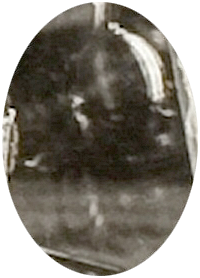 W
WThe Cherub with Chariot egg or Angel with Egg in Chariot is a Tsar Imperial Fabergé egg, one of a series of fifty-two jeweled eggs made under the supervision of Peter Carl Fabergé for the Russian Imperial family. It was crafted and delivered in 1888 to the Tsar of Russia, Alexander III. This is one of the lost Imperial eggs, so few details are known about it.
 W
WThe Clover Leaf egg is a jewelled Easter egg made under the supervision of the Russian jeweller Peter Carl Fabergé in 1902 for Tsar Nicholas II of Russia. It was presented by Nicholas as an Easter gift to his wife, the Tsarina Alexandra Feodorovna. It is currently held in the Kremlin Armoury Museum in Moscow, and it is one of the few imperial Fabergé eggs that were never sold after the Russian Revolution.
 W
WThe Cockerel egg was crafted by Peter Carl Fabergé in his set of Imperial Fabergé eggs. The egg was given in 1900 by Tsar Nicholas II to Empress Maria Feodoronova as a gift. The egg has a mechanism on the top rear that enables its bird to come out and move.
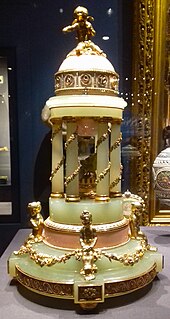 W
WThe Colonnade egg is a jewelled enameled Easter egg made by Henrik Wigström under the supervision of the Russian jeweller Peter Carl Fabergé in 1910. The Fabergé egg was made for Nicholas II of Russia, who presented it to his wife, Alexandra Feodorovna to celebrate the birth of their only son, the tsarevich Alexei. As a clock-egg, the Colonnade egg contained no surprise.
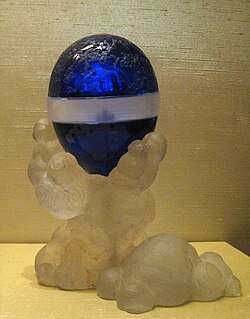 W
WThe Constellation egg is one of two Easter eggs designed under the supervision of Peter Carl Fabergé in 1917, for the last Tsar of Russia, Nicholas II as an Easter gift to his wife, the Tsarina Alexandra Feodorovna. It was the last Imperial Fabergé egg designed. It remains unfinished.
 W
WThe Danish Palaces egg is an Imperial Fabergé egg, one of a series of fifty-two jeweled eggs made under the supervision of Peter Carl Fabergé for the Russian Imperial family. It was crafted and delivered to the then Tsar of Russia, Alexander III who presented it to his wife, Maria Feodorovna on Easter day 1890. The egg is currently owned by the Matilda Geddings Gray Foundation and housed in the Metropolitan Museum of Art in New York City, New York.
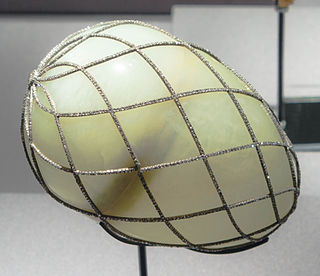 W
WThe Diamond Trellis egg is a jewelled enameled Easter egg made by August Holmström under the supervision of the Russian jeweller Peter Carl Fabergé in 1892. It is one of the Imperial Fabergé eggs, made for Alexander III of Russia, who presented it to his wife, the Empress Maria Feodorovna. The egg is owned by Dorothy McFerrin, as part of the collection acquired by her and her husband, Artie McFerrin, who died on August 8, 2017, and is on display at the Houston Museum of Natural Science.
 W
WThe Empire Nephrite egg is a jewelled Easter egg, purported to be one of the Imperial Eggs made under the supervision of the Russian jeweller Peter Carl Fabergé in 1901–1902 for Nicholas II of Russia, who presented it to his mother, the Dowager Empress Maria Feodorovna, at Easter 1902. This provenance has been challenged by some Fabergé experts.
 W
WThe Fifteenth Anniversary Egg is an Imperial Fabergé egg, one of a series of fifty-two jewelled enameled Easter eggs made under the supervision of Peter Carl Fabergé for the Russian Imperial family.
 W
WThe First Hen egg or Jeweled Hen egg is an Imperial Fabergé egg. It became the first in a series of more than 50 such jeweled eggs made under the supervision of Peter Carl Fabergé for the Russian Imperial family. It was delivered to Tsar Alexander III and given to his wife Maria Feodorovna in 1885. The tsarina enjoyed the egg so much that Alexander III quickly placed a standing order with Fabergé to create a new egg for his wife every Easter thereafter, requiring only that each egg be unique and that it contain some kind of "surprise" within it. This particular egg is now a part of the permanent collection of the Fabergé Museum in Saint Petersburg, Russia.
 W
WThe Gatchina Palace egg is a jewelled, enameled Easter egg made under the supervision of the Russian jeweler Peter Carl Fabergé in 1901, for Nicholas II of Russia. Nicholas II presented it to his mother, the Dowager Empress Maria Feodorovna, at Easter in 1901. The egg opens to reveal a surprise miniature gold replica of the Gatchina Palace that was built for Count Grigory Orlov and was later acquired by Tsar Paul I. It is one of two Imperial Easter eggs in the collection of the Walters Art Museum in Baltimore, Maryland.
 W
WThe Imperial Coronation egg is a jewelled Fabergé egg made under the supervision of the Russian jeweller Peter Carl Fabergé in 1897 by Fabergé ateliers, Mikhail Perkhin and Henrik Wigstrom. The egg was made to commemorate Tsarina, Empress Alexandra Fyodorovna.
 W
WThe Lilies of the Valley egg is a jewelled Fabergé egg made under the supervision of the Russian jeweller Peter Carl Fabergé in 1898 by Fabergé ateliers. The supervising goldsmith was Michael Perchin. The egg is one of the two eggs in the Art Nouveau style. It was presented on April 5 to Tsar Nicholas II, who gave it as a gift to his wife, the Tsarina, Empress Alexandra Fyodorovna. The egg is part of the Victor Vekselberg Collection, owned by The Link of Times Foundation and housed in the Fabergé Museum in Saint Petersburg, Russia.
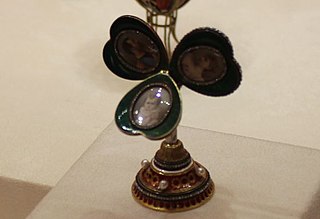 W
WThe Mauve egg is a jewelled Easter egg made under the supervision of the Russian jeweller Peter Carl Fabergé in 1897, for Nicholas II of Russia, who presented it to his mother, the Dowager Empress Maria Feodorovna on April 18, 1897.
 W
WThe Memory of Azov is a jewelled Easter egg made under the supervision of the Russian jeweller Peter Carl Fabergé in 1891 for Tsar Alexander III of Russia. It was presented by Alexander III as an Easter gift to his wife, the Tsarina Maria Feodorovna. It is currently held in the Kremlin Armoury Museum in Moscow.
 W
WThe Mosaic egg is a jewelled enameled Easter egg made under the supervision of the Russian jeweller Peter Carl Fabergé in 1914. The Fabergé egg was made for Nicholas II of Russia, who presented it to his wife, the Empress Alexandra Feodorovna on Easter 1914. Its Easter 1914 counterpart is the Catherine the Great egg.
 W
WThe Uspenski Cathedral egg or Moscow Kremlin egg is a jewelled Easter egg made under the supervision of the Russian jeweller Peter Carl Fabergé in 1906 for Tsar Nicholas II of Russia. It was presented by Nicolas II as an Easter gift to his wife, the Czarina Alexandra Fyodorovna. It is currently held in the Kremlin Armoury Museum in Moscow, and it is one of the few imperial Fabergé eggs that were never sold after the Russian Revolution.
 W
WThe Napoleonic egg, sometimes referred to as the Imperial Napoleonic egg, is a Fabergé egg, one of a series of fifty-two jewelled eggs made under the supervision of Peter Carl Fabergé. It was created in 1912 for the last Tsar of Russia Nicholas II as a gift to his mother the Dowager Empress Maria Fyodorovna. The egg is part of the Matilda Geddings Gray collection of Faberge and is currently long term installation at Metropolitan Museum of Art in New York City, New York.
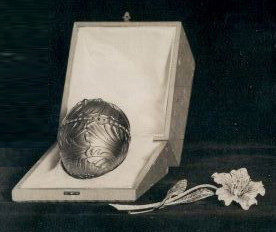 W
WThe Nécessaire egg is an Imperial Fabergé egg, one of a series of fifty-two jeweled eggs made under the supervision of Peter Carl Fabergé for the Russian Imperial family. It was crafted and delivered to the then Tsar of Russia, Alexander III who presented it to his wife, Maria Feodorovna on Easter day 1889. The egg is one of the lost Imperial eggs, but is known to have survived the Russian Revolution and was sold by Wartski in London in 1952.
 W
WThe Order of St. George Egg, also called the Cross of St. George Egg, is an enameled Easter egg made under the supervision of the Russian jeweller Peter Carl Fabergé in 1916, for Nicholas II of Russia, who presented the Fabergé egg to his mother, the Dowager Empress Maria Feodorovna.
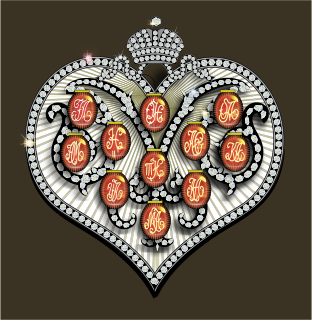 W
WThe Pansy egg or Spinach Jade egg is one of the Imperial Russian Fabergé eggs, and it was commissioned in 1899 by Tsar Nicholas II as an Easter gift for his mother, Dowager Empress Maria Feodoronova. Its design was overseen by the jeweler Peter Carl Fabergé. It is one of only two done in the Art Nouveau style.
 W
WThe Dowager Fabergé egg, is a jewelled Easter egg made under the supervision of the Russian jeweller Peter Carl Fabergé in 1898. The egg was made for Nicholas II of Russia, who presented it to his mother, the Dowager Empress Maria Feodorovna on Easter 1898.
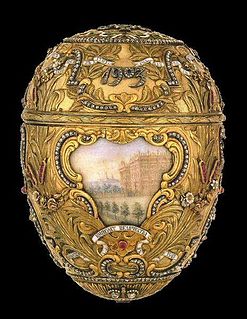 W
WThe Peter the Great egg is a jewelled Easter egg made under the supervision of the Russian jeweler Peter Carl Fabergé in 1903 for the last Tsar of Russia, Nicholas II. Tsar Nicholas presented the Fabergé egg to his wife, the Czarina Alexandra Fyodorovna. The egg is currently located at the Virginia Museum of Fine Arts in Richmond, Virginia, in the United States.
 W
WThe Red Cross with Imperial portraits egg is a jewelled and enameled Easter egg made by Henrik Wigström (1862–1923) under the supervision of the Russian jeweller Peter Carl Fabergé in 1915, for Nicholas II of Russia, who presented the Fabergé egg to his mother, the Dowager Empress Maria Feodorovna, in the same year.
 W
WThe Red Cross with Triptych egg, also known as Red Cross Triptych egg or Red Cross Egg with Resurrection Triptych, is an enameled Easter egg made under the supervision of the Russian jeweler Peter Carl Fabergé in 1915, for Nicholas II of Russia. Nicholas II presented the Fabergé egg to his wife Empress Alexandra Fyodorovna on Easter 1915.
 W
WThe Renaissance egg is a jewelled agate Easter egg made by Michael Perchin under the supervision of the Russian jeweller Peter Carl Fabergé in 1894. The egg was made for Alexander III of Russia, who presented it to his wife, the Empress Maria Feodorovna.
 W
WThe Rock Crystal egg or Revolving Miniatures egg is an Imperial Fabergé egg, one in a series of fifty-two jeweled eggs made under the supervision of Peter Carl Fabergé for the Russian Imperial family. It was created in 1896 for Empress Alexandra Feodorovna. The egg currently resides in the Virginia Museum of Fine Arts.
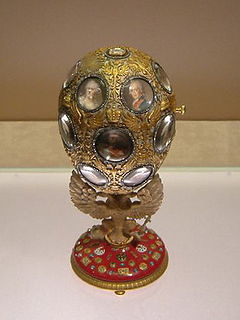 W
WThe Romanov Tercentenary egg is a jewelled Easter egg made under the supervision of the Russian jeweller Peter Carl Fabergé in 1913, for Tsar Nicholas II of Russia. The Fabergé egg was presented by Nicolas II as an Easter gift to his wife, the Tsaritsa Alexandra Fyodorovna. It is currently held in the Kremlin Armoury Museum in Moscow.
 W
WThe Rose Trellis egg is a jewelled enameled Imperial Fabergé egg made in Saint Petersburg, Russia under the supervision of the jeweler Peter Carl Fabergé in 1907, for Tsar Nicholas II of Russia. It was presented by Tsar Nicholas II to his wife, the Empress Alexandra Feodorovna, on Easter 1907. It is now in the Walters Art Museum in Baltimore, Maryland.
 W
WThe Rosebud egg is a jewelled enameled Easter egg made by Michael Perchin under the supervision of the Russian jeweller Peter Carl Fabergé in 1895, for Nicholas II of Russia, who presented the egg to his wife, Empress Alexandra Feodorovna. It was the first Fabergé egg that Nicholas presented to Alexandra.
 W
WThe Standart Yacht egg is a jewelled Easter egg made under the supervision of the Russian jeweller Peter Carl Fabergé in 1909 for Tsar Nicholas II of Russia. It was presented by Nicolas II as an Easter gift to his wife, the Czarina Alexandra Fyodorovna. It is currently held in the Kremlin Armoury Museum in Moscow, and it is one of the few imperial Fabergé eggs that were never sold after the Russian Revolution.
 W
WThe Swan egg is a Fabergé egg, one in a series of fifty-two jewelled eggs made under the supervision of Peter Carl Fabergé. Commissioned in 1906 by Tsar Nicholas II, the egg was presented to the Dowager Empress Maria Feodorovna on Easter that year for her 40th wedding anniversary.
 W
WThe Third Imperial egg is an Easter Fabergé egg created in the workshop of Peter Carl Fabergé for the Russian tsar Alexander III and presented to his wife, Maria Feodorovna, on Orthodox Easter of 1887. The egg was created in Louis XVI style and it consists of a solid 18K gold reeded case resting on a gold "annulus" (ring) with waveform decorations held up by three sets of corbel-like legs which end in lion's paws. Joining these legs are festoons of roses and leaves made in a variety of colored gold alloys and joined in the middle of each side by matching oval cabochon sapphires. Above each sapphire is a gold bow decorated with a series of tiny diamonds, and the front of the egg has a single much-larger diamond in an old-mine diamond clasp which when pressed releases the egg's lid to reveal its surprise. The egg was lost for many years, but was rediscovered in 2012. The rediscovery of this egg was announced publicly and covered in many news stories in 2014.
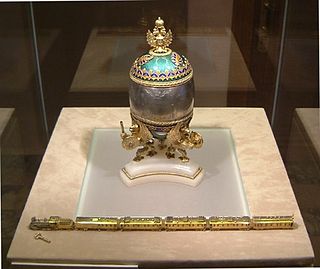 W
WThe Trans–Siberian Railway egg is a jewelled Easter egg made under the supervision of the Russian jeweller Peter Carl Fabergé in 1900 for Tsar Nicholas II of Russia. The Fabergé egg was presented by Nicolas II as an Easter gift to his wife, the Tsarina Alexandra Fyodorovna. It is currently held in the Kremlin Armoury Museum in Moscow.
 W
WThe Tsarevich egg, also known as the Czarevich egg, is a Fabergé egg, one of a series of jewelled eggs made under the supervision of Peter Carl Fabergé. It was created in 1912 for Empress Alexandra Fyodorovna as a tribute by Fabergé to her son the Tsarevich Alexei (Alexei). The egg is currently in the Virginia Museum of Fine Arts in Richmond, Virginia., US.
 W
WThe Twelve Monograms egg, also known as the Alexander III Portraits egg, is an Easter egg made under the supervision of the Russian jeweller Peter Carl Fabergé in 1896 for Tsar Nicholas II of Russia. It was presented by Nicholas II to his mother, the Dowager Empress Maria Feodorovna. The egg was the second Fabergé egg ever given by Nicholas II to his mother as an Easter present.